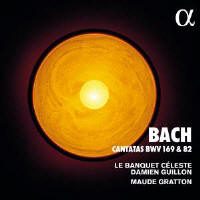Texte paru dans: / Appeared in: |
|
|
Reviewer: J.
F. Weber.
The disc is well filled, but
two cantatas is short for the typical Bach cantata CD. Two factors make the
disc interesting. One is the soloist. BWV 169, usually sung by a contralto,
is taken by the countertenor and director of the ensemble, while BWV 82,
well known as a bass solo, is sung in the alternative version for alto that
Bach arranged. This very coupling was recorded by Janet Baker under Yehudi
Menuhin, and BWV 82 was also sung in the alto version by countertenor René
Jacobs (Fanfare 12:1) and Nathalie Stutzmann (20:2). (It is in the original
key, unlike the soprano arrangement.) Guillon is a remarkable singer. I have
heard so many countertenors whose voices are unsatisfying (I know, that can
be said for any vocal range), but Guillon projects strongly without being
unpleasant, hooty, or irritating. I should name a few others who have won my
admiration in the past: Russell Oberlin, Henri Ledroit, René Jacobs,
Yoshikazu Mera, Franz Vitzthum (the list is not exhaustive). This is the
level of Guillon’s singing. The other point to note is the organ music. Three arrangements of the same chorale are placed between the two cantatas. This is a sizable interlude, for together the three pieces run 18 minutes. The Prelude and Fugue is placed last, an appropriate nine-minute conclusion to the program. I have known BWV 543 since Carl Weinrich’s recording on a Swedish organ for Westminster, so I can appreciate this splendid performance. The recording venue was determined by the choice of the organ in the Reformed Church of Bouclier, Strasbourg, an organ built in 2007 on the lines of organs in Thuringia in Bach’s lifetime. Guillon’s ensemble consists of three singers (in the chorale movement of No. 169) and 10 players, so this is decidedly minimalist. The decision on this disc, then, relies entirely on the soloist’s voice, well worth hearing. | |
|
|
|
|
|
|
|
Cliquez l'un ou l'autre
bouton pour découvrir bien d'autres critiques de CD |
|




